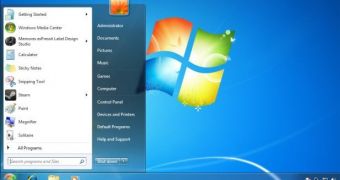Windows 8 is alive and kicking, but although the Redmond-based devices and services firm (as Mr. Ballmer calls his company right now) is apparently pretty disappointed with the sales performance of its software.
We’ve heard that Ballmer and the other Microsoft executives are blaming the PC industry for the lack of devices running its Windows 8 OS. While hardware manufacturers could be more or less at fault, this isn’t entirely true.
Microsoft launched a new operating system and together with it, the company debuted a long list of changes, some of them aimed at the GUI. It removed the Start button and the Start Menu, but users now have a brand-new Start Screen that’s supposed to play the same role as the two traditional Windows elements.
The problem is that it doesn’t.
The Start Screen is great on tablets and devices with touchscreen displays and it seems completely optimized for the touch. It’s an excellent feature whenever you wish to swipe around and see the installed apps, but doing the same thing with a mouse is painful.
Does that mean that Windows 8 is not the right OS for my desktop PC?
Yes and no. If you wish to take advantage of the Modern GUI, then no, deploying Windows 8 on a desktop computer is not at all a good idea. Or at least, not until you get used to it. The Metro/Modern interface is mostly designed for the touch, so all apps run in full screen. You have a Windows Store to deploy apps and you need to use the mouse scroll more than ever.
On the other hand, if you plan to use Windows 8 just like any other Windows flavor and rely on the “desktop,” the Microsoft’s latest OS should do the job. But if it does the same thing as Windows 7, why should we even bother to upgrade?
Once again, there’s a major setback with this “desktop” mode. Every time you wish to launch an app, you have no other option than to go over to the Start Screen and click on a live tile. Microsoft has somehow managed to mix the “GUIs” in a way that might actually annoy plenty of users. That’s because there’s no Start button to do the job.
Evolution doesn’t hurt anyone
If we have a look at the other Windows versions, all come with a Start button and a Start Menu. They bring only slight interface changes, but all of them are based on the same layout that actually allows consumers to do their job without additional training. Or without the need for some days to get used to the new OS.
Steven Sinofsky, the former Windows boss, said during the Windows 8 launch event that Microsoft’s Start Screen has the same fate as the Start button. Back in the ‘90s when Microsoft rolled out Windows 95, the Start button was considered a pretty confusing feature, but all users have finally became addicted to it.
Sinofsky was right. Evolution doesn’t hurt anyone and some people actually consider Windows 8 a fairly intuitive operating system. With or without a Start button.
It may also be bad timing. Microsoft rolled out so many GUI changes when the market wasn’t really prepared for all of them. Windows 7 was such a successful product that it was pretty difficult for a new operating system to hit the market and impress from the very beginning.
But in the end, I think that Microsoft’s biggest mistake is that it refuses to listen to the voice of users. Most of you are asking for a Start button, but Steve Ballmer claims that Microsoft has no intention to bring back this feature in Windows 8. Microsoft tells users to upgrade to Windows 8, but they won’t do it just because the company tells them to do it. They need an operating system that really helps them do their job. It’s their money after all.
And Linux is freeware by the way. Thank God it’s not so easy to use.

 14 DAY TRIAL //
14 DAY TRIAL //